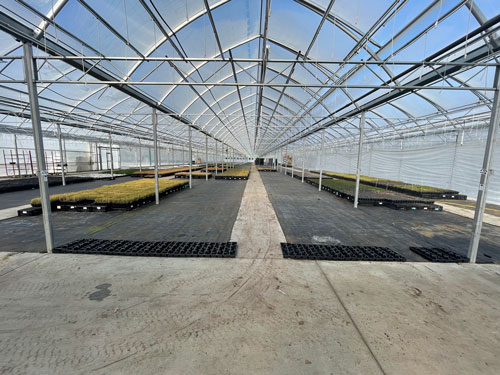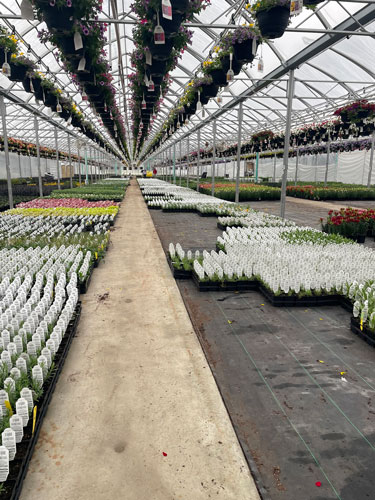8/1/2022
End-of-Season Wrap-up
Paul Pilon

Spring is in the rearview mirror and finally we get a chance to catch our breath and regroup. I try not to become too complacent during the summer, as next year’s production is in the not-too-distant future. I like to use the summer as an opportunity to review the good, the bad and the ugly from the spring growing season.
Pictured: Documenting future improvements while the crops are still on the ground rather than after they’re all gone allows growers to capture this information rather than relying on their memories months down the road when they begin to plan for next year’s crops.
During this time, it’s helpful to regroup and look at past successes and failures to modify next year’s production plans to set up the best possible outcomes for the next growing season. My emphasis is not so much proudly remembering all the things that went well, but rather focusing on the things that didn’t. My goal is to find ways to tweak the production plans and cultural practices so the same less-than-desirable outcomes don’t reoccur in future production cycles.
Are you like me? I think my memory is great and I’ll easily remember certain details about future crop modifications or enhancements when the time comes. But months down the road when I’m actively modifying the crop plans and adjusting future cultural practices, I can’t recall some of these details I was so certain I would remember. I’d love to blame it on old age, but instead I’ll give myself a pass, as it’s impossible to remember specific details on hundreds of cultivars, numerous container sizes and multiple production blocks.
Items to track
There are numerous items that can be tracked or documented over the course of the growing season. Each grower looks at crops differently and likely has their own specific long-term goals in mind, as well as the unanticipated crop observations to take note of over the course of the spring growing season. Below is a list of several of the items I evaluate when observing my perennial crops.
Scheduling
• Did the crop finish on time?
• How many weeks ahead or behind schedule was it?
• Did a different-than-planned starting material (size/type) influence the crop’s ready time?
• Were there any environmental factors that affected its schedule?
• Was the crop grown in the right environment?
• Was the crop trimmed or pinched? If so, how did that affect crop timing?
• Should a pinch or trim be “scheduled” into the production plan?
Plant growth regulators
• Were PGRs applied (sprays or drenches)?
• What were the application rates and how frequently were they applied?
• Were these applications effective?
• What adjustments need to be made (application method, rate, timing, frequency and application interval)?
• How did PGRs influence plant quality?
• Was crop timing affected?
Insects and diseases
• What insects and disease were observed?
• Were the crops routinely scouted to detect these problems early?
• How effective were management strategies if they were implemented?
• Would preventative strategies be beneficial in the future?
• Do any of the current preventative or curative programs need to be modified?
Irrigation/fertility
• Were the crops irrigated properly?
• Could the plants be grouped differently to help improve water management?
• Were any nutrient deficiencies or toxicities observed?
• Did the crops grow too large, appear lush or require too many PGR applications? (This can be an indication of over-watering and over-fertilizing.)
• Did the crops appear normal, but remain small or take too long to fill out the containers? (This can be an indication of under-watering or under-
fertilizing.)
• When was the last time a nutrient analysis was performed on the water source?
• Is the EC and pH of the irrigation water being monitored daily, weekly, monthly or never?
Quality control
• Did the quality of the starting materials influence the crop’s appearance, shrink and final plant quality?
• Were the crops planted properly (proper planting depth)?
• Was any plant maintenance—such as pinching, trimming and spacing—done on time?
• Is there anything that could’ve been done to improve plant quality?
It can be challenging to keep up with the day-to-day requirements of the plants currently on the ground while trying to also observe and collect information to help improve future crops. I’ve found this multitasking to be absolutely critical to my past, present and future successes. I’ve made these observations several ways over the years using various methods, such as taking notes on a notepad to entering this data directly into a tablet containing our production software.
Pictured:  Observing the crops and taking good notes during the growing season is very helpful for determining areas for future improvements.
Observing the crops and taking good notes during the growing season is very helpful for determining areas for future improvements.
Perhaps the most practical, useful and easy-to-manage method that most every grower has access to is to enter these notes into a spreadsheet. I prefer to have the inventory downloaded into the spreadsheet with each item’s size and location to reduce the number of manual entries I make, using a different column for the types of note you’d like to document. For example, one column for PGRs, using another column for scheduling observations and so on. Collecting data in this manner makes it super easy to sort, run filters and analyze the information when the time comes.
Change is constant and is often beneficial, if not necessary, for growers to move forward, stay relevant and remain profitable. Evaluating past crop successes and failures is an important process in moving forward. Don’t change things just for the sake of changing them; if it’s not broken, don’t fix it. With an open mind and the notes you collect each year during the growing season, you’ll likely be able to identify several areas for improvements. I’m not talking about reinventing the wheel or painstakingly redeveloping the overall production plans, but finding meaningful areas for things to be tweaked. Sometimes the smallest changes can have the greatest impact. GT
Paul Pilon is editor-at-large of the Perennial Pulse e-newsletter and Director of Growing at Opel Growers in Hudsonville, Michigan. He can be reached at paul@opelgrowers.com.